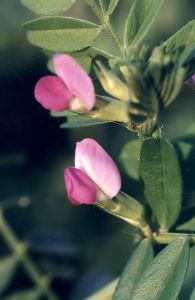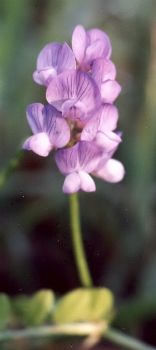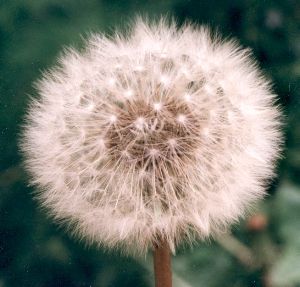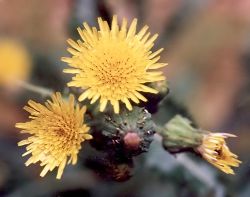Lawn Flowers
by Valerie (June 19, 2000)
revised August 29, 2003
While we try to maintain a presentable yard, with grass in the lawn and everything else in the gardens, the plants don't always follow the rules. Most of our gardens are delineated with large rocks, a good percentage of which came from just below the surface of the gardens themselves. These rock borders look obvious enough to us but the plants find them to be no obstacle, brazenly breaching the barriers and spreading out into the lawn (or into the gardens in the case of the grass).

Since I like variety more than uniformity, I prefer the mix of many plants to a monoculture of one species of grass, and cultivate the lawn accordingly. As long as the plants are not too aggressive, displacing large amounts of grass, and don't produce thorns, spines or nuisance burrs, they are welcome to grow in the lawn. I do a certain amount of weeding to keep large spiny plants like thistles at bay, but always encourage the pretty ones and enjoy the kidney weed, rain-lilies, unusual sedges and other interesting small plants.
The other species of vetch is deer pea vetch (Vicia ludoviciana). This plant is less common and more delicate, with thinner stems, smaller leaves, and tiny clusters of purple flowers. While the common vetch can push up through the St. Augustine grass in our yard, deer pea vetch seems to prefer the edges of the gardens, where it has little competition. Both species grow during the winter, flowering early in the spring, and dying off when it gets hot.
An all-time favorite flower is the showy primrose (Oenothera speciosa). This short, pink-flowered perennial was very common in our lawn during the first few years, before the grass started to crowd it out. It continues to grow well in the borders of the gardens and in some of the walkways. It is another cool-weather plant and after blossoming and producing seed, it dies back. While the leaves are usually solid green, in one area of our yard the plants have foliage with green and dark red stripes and sometimes I've seen some with white and green variegation.
The ten-petal anemone (Anemone heterophylla) is very common in our yard and also tends to bloom early in the spring. It looks like it has more than ten petals but that is because the sepals are also white. The leaves of this plant are very low growing and the flowers emerge on the end of a long stem. The center of the flower is usually about an inch long and after the petals whither, the seeds puff out and get blown away, hence its other common name: windflower. There is an infrequent variation of this flower which is purple and I try to spread the seeds of those flowers more.
The final subject of this essay is the Texas dandelion or false dandelion (Pyrrhopappus multicaulis). It is one of my favorites because of its beautiful yellow flowers and dainty leaves. It rarely grows in the gardens, but it sometimes decorates the lawn during the early part of the summer. While not as aggressive as some plants, Texas dandelion occasionally puts on quite a show, with its lemon-colored flowers. It is also edible, but supposedly more bitter than regular dandelions. When pulling up young thistles, I'm always careful to leave this plant alone and we try not to mow it down before it sets seed. |
 Most lawn flowers bloom only for a short time, then die back without a trace. This is the case of two species of vetch that grow in our yard. Common vetch (Vicia sativa) is a rather robust plant with pinkish flowers. It begins growing late in the winter and covers rather large areas of grass. I sometimes have to eliminate this plant from the gardens because it chokes out newly sprouting seedlings and other plants, but the plants do no harm to the still-dormant grass and, since they (like many legumes) possess root nodules with nitrogen-fixing bacteria, I often pull up large quantities to add to our compost bins. The seeds of common vetch form in a pod, just like most other legumes. When the pod is mature, it turns dark brown and the two halves curl apart, releasing the seeds. Common vetch is also called spring vetch and garden vetch.
Most lawn flowers bloom only for a short time, then die back without a trace. This is the case of two species of vetch that grow in our yard. Common vetch (Vicia sativa) is a rather robust plant with pinkish flowers. It begins growing late in the winter and covers rather large areas of grass. I sometimes have to eliminate this plant from the gardens because it chokes out newly sprouting seedlings and other plants, but the plants do no harm to the still-dormant grass and, since they (like many legumes) possess root nodules with nitrogen-fixing bacteria, I often pull up large quantities to add to our compost bins. The seeds of common vetch form in a pod, just like most other legumes. When the pod is mature, it turns dark brown and the two halves curl apart, releasing the seeds. Common vetch is also called spring vetch and garden vetch.




